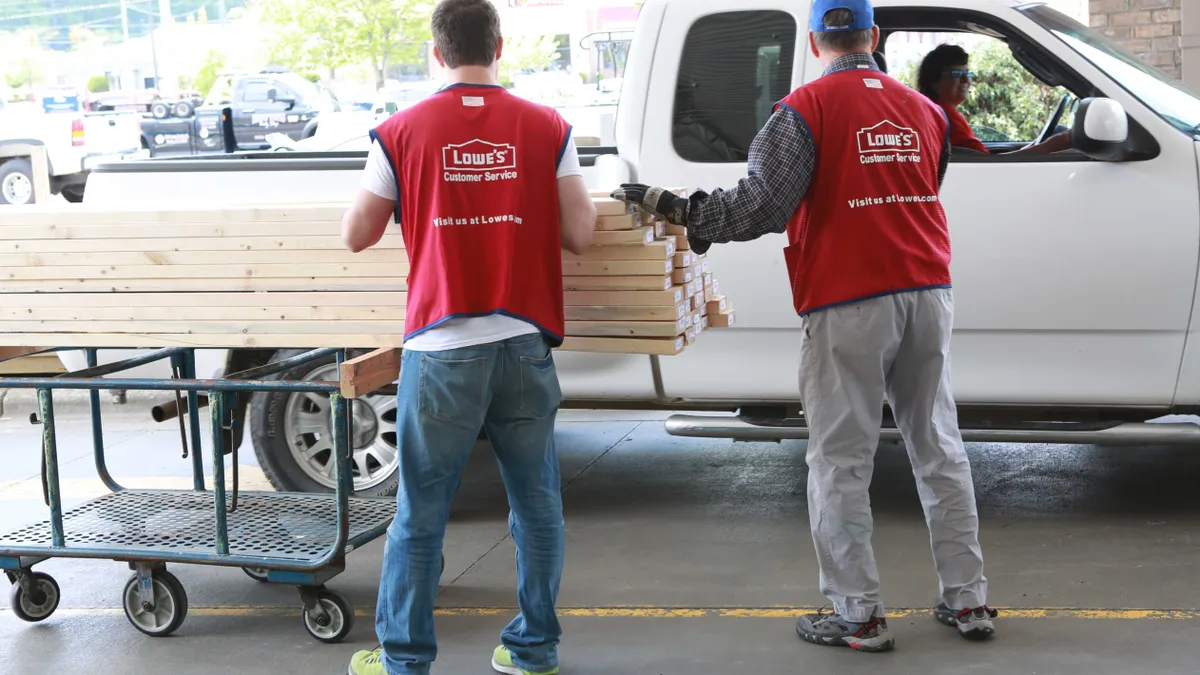While much of the industry has been hard-hit by the coronavirus pandemic, home improvement retailers remain an unexpected bright spot.
Home Depot on Tuesday reported second quarter net sales were up 23.4% to $38 billion, and comparable sales were up 23.4%. In the U.S., comp sales surged some 25%. The home improvement retailer also reported net income increased 24.5% year over year to $4.3 billion.
The company said there was increased adoption of its fulfillment options, evidenced by the fact that more than 60% of online orders were fulfilled at the store. Home Depot's digital platforms grew some 100% during the period and its mobile app saw "a record number of downloads," CEO Craig Menear said on a Tuesday call with analysts discussing second quarter results.
"These results confirm our belief that we have been making investments in the right areas of our business and that those investments are resonating with our customers," he added.
Meanwhile, Lowe's on Wednesday reported net sales of $27.3 billion, a 30% increase from the year-ago quarter. Total comps rose 34.2%, while U.S. comps jumped more than 35%.
"We delivered very strong second quarter results, with all merchandising divisions posting comparable sales growth exceeding 20% and all U.S. geographic regions delivering comparable sales growth of at least 30%," Lowe's CEO Marvin Ellison said in a statement. "Sales were driven by a consumer focus on the home, core repair and maintenance activities, and wallet share shift away from other discretionary spending."
The robust comps growth was also more than 10 percentage points higher than that of competitor Home Depot. But in terms of dollar amount, "Home Depot's sales uplift was just shy of ... $1 billion more than Lowe's," Neil Saunders, managing director of GlobalData Retail, said in emailed comments. "Nevertheless, these figures show that thanks to the various improvements made by management, Lowe's has been able to capitalize on shifts in consumer behavior."
Ellison has been working to right missteps in the company's online business since his arrival in 2018. Lowe's in 2019 said it was investing half a billion dollars annually until 2021 in order to transform the technological makeup of its business. This included opening a new tech center in Charlotte, North Carolina.
And those efforts appear to be working as the company reported a 135% year-over-year increase in website sales from the year-ago period.
Remaining open as essential retailers during the lockdown helped propel sales. But more than that, the category saw increased demand due to consumers taking on more home improvement projects as they hunkered down in their houses. According to GlobalData Retail, 73% of consumers took on a home or garden project this quarter, up from 56% who did so last year.

The federal pandemic-related assistance also helped encourage consumers to spend in the last several months. According to Michael Maloof, associate director of consumer brand insights at Earnest Research, consumer spending in the home category "skyrocketed" in April after stimulus checks were deposited.
That spending has carried through in recent months. According to July retail sales from the Commerce Department, total sales in the categories Retail Dive tracks were up 11% year over year. Within that, sales in the furniture and home category were up 1%, while sales in apparel and electronics declined some 20% and 3%, respectively.

However, that relief has since ended and Congress left for summer recess before coming to an agreement for further assistance, making consumer spending patterns more unpredictable.
"There is no doubt that money from enhanced stimulus and benefits has fueled the ability to spend, but so too has curtailment of expenditure on other activities such as travel and dining out – money from these things has been funneled into the home," Saunders said. "How long these trends continue remains to be seen, but consumers are clearly still keen to invest in their houses."
But spending to improve the home remains a priority among consumers, as Saunders and Wedbush analyst Seth Basham note, and the category may be better positioned than others in the industry, namely apparel.
Though sales growth has slowed in the home improvement sector since its June peak, Basham said, it continues to be "robust and should remain well above pre-pandemic levels through at least the back half of the year as homeowners continue to invest in their homes where they continue to spend a disproportionate amount of their time."














